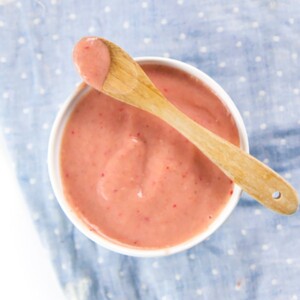Learn how to serve nutritious, tasty peaches for baby-led weaning with our helpful guide. A powerful little fruit, peaches are full of essential nutrients and antioxidants, perfect for boosting immune function and supporting healthy babies and toddlers.
Medically reviewed and cowritten by Jamie Johnson, Registered Dietitian Nutritionist (RDN), and Lauren Braaten, Pediatric Occupational Therapist (OT).
Peaches for BLW
Juicy, sweet and bursting with summer flavor, peaches are a perfect first food to introduce to your baby. A good source of vitamin C, they can be eaten plain, added to smoothies or as toppings for yogurt or oatmeal.
Are you wondering if your little one is ready to eat peaches? Or how to serve peaches for baby-led weaning? And are peaches a choking hazard?
In this guide, we’ll cover all the information you need in order to serve this beautiful summer fruit for baby-led weaning. Learn about the benefits of peaches for baby, FAQs, helpful tools and expert feeding tips.
First time making homemade baby food? Then, I would suggest that you start by reading my very in-depth Complete Guide to Baby-Led Weaning – which covers what exactly is baby-led weaning, to every parent’s concern of baby-led weaning and choking, this guide goes over it all. I will also share how to know when baby is ready for BLW, the top 10 best first foods, a helpful sample blw feeding schedule, helpful tools to have on hand, and much much more!
You can also check out my best-selling cookbook for even more information and recipes!

Reasons to Love Peaches for BLW
- Great for baby-led weaning – 6+ months
- Also great for the finger food stage – 9+ months
- Full of essential nutrients for baby
- Different ways for baby to eat – spoon-fed or self-feed
- Easy to make – minimal prep work required
Health Benefits of Peaches
Peaches are packed with benefits!
- A good source of vitamin C for iron absorption and immune system support.
- Contain fiber for a healthy digestive system and potassium for muscle function and a healthy heart beat.
- Also contains other essential vitamins and minerals such a variety of B vitamins, vitamins A, E, and K, and copper.
Spices to Add
Peaches are delicious served as-is, or you can add different spices to help expand your baby’s palate. Some of the best spices that go well with peaches include cinnamon, cardamon, clove, ginger, nutmeg and thyme.

Frequently Asked Questions
Yes, peaches can definitely be baby’s first food if you choose. Peaches can be given to your baby as soon as they start eating solid foods at around six months.
No, peaches are not a common allergen, however, as with any food, start with a small portion and be aware of any signs that might be an allergic reaction after introducing it.
Peaches aren’t typically a choking hazard, unless they aren’t ripe. Make sure to serve soft and ripe peaches in an age-appropriate form.
Peaches are not known to cause constipation in babies, but are actually one of the “P” fruits (such as pears, prunes, plums) known to help alleviate constipation.

How to Prepare Peaches for Baby-Led Weaning
You can serve peaches to babies and toddlers in halves, slices, diced, or whole form, depending on their age. You can also choose to leave the skin on or peel them, depending on baby’s needs and skill level.
Peach Puree: You can offer purees and still allow your baby to lead the way with self-feeding by offering the puree on a self-feeding spoon, by placing a few spoonfuls of the puree directly on the tray or in a bowl for your baby to dip their fingers into, or you can even use the puree as a dip for solid foods such a banana or piece of toast.
Helpful Tools
Here are some products that help you make and serve pears to your baby even easier! To find even more products that I love, make sure to check out my online shop.
Baby-Led Weaning Feeding Tips
- Frozen peaches are just as nutritious as fresh and are available all year round, so if you can’t find fresh ones, go for frozen. If buying canned, avoid those packed in syrup, which is loaded with sugar.
- It may seem counterintuitive, but offering younger babies a larger piece, such as peach havles or thick slices will actually reduce choking risks, as they are less likely to break off a larger piece that’s difficult to manage. Serving larger pieces is also easier for younger babies (6-9 months) to grasp while eating.
- Peaches can sometimes be slippery, so try rolling in finely ground baby cereal, hemp seeds, ground flaxseeds, or finely shredded coconut to help give your baby a better grasp.
- Pureed and mashed peaches are also great for adding to yogurt, oatmeal, and other pureed fruits and veggies.
- Peaches are on the EWG’s Dirty Dozen list so if it fits your budget, you may want to choose organic to avoid synthetic pesticides.

How to Serve Peaches for Baby-Led Weaning
Peaches are typically slippery and firm, which can increase the risk of choking on this fruit. To decrease this risk, only serve very ripe, soft peaches.
Whole, thick slices, halved with pit removed or as a puree (6-9+ months): Thick slices will be easier for your baby to pick up at this age. If serving a halved peach, make sure it is ripe for the soft texture and take out the pit. You can roll the peach halves or slices in finely ground-up nuts, hemp seeds, chia seeds, or shredded coconut to help your baby grasp it. You can also serve peaches to your baby as a puree on a self-feeding spoon.
Slices or small diced pieces (12+ months): Bite-sized pieces will help baby practice their pincer grasp. If they are too slippery, try leaving the skin on or rolling them in crushed coconut, hemp seeds or chia seeds to make them easier to pick up.
Storage
You can store cut peaches wrapped in a paper towel in an air-tight container in the fridge for up to 2 days.
More Peach Recipes for Baby

The Perfect Peach Yogurt (3 ingredients)
The perfect pairing – flavorful peaches and creamy yogurt! This family-friendly Peach Yogurt is made with simmered fresh or frozen peaches and a few spices, then swirled in creamy yogurt. Top with granola and or any fun toppings for the perfect snack or lunch side. For ages 6+ months.
Get the recipe



Age: 6+ months
Yield: 2-3 small portions for baby
How to Cut:
Whole, thick slices, halved with pit removed or as a puree (6-9+ months): Thick slices will be easier for your baby to pick up at this age. If serving a halved peach, make sure it is ripe for the soft texture and take out the pit. You can roll the peach halves or slices in finely ground-up nuts, hemp seeds, chia seeds, or shredded coconut to help your baby grasp it. You can also serve peaches to your baby as a puree on a self-feeding spoon.
Slices or small diced pieces (12+ months): Bite-sized pieces will help baby practice their pincer grasp. If they are too slippery, try leaving the skin on or rolling them in crushed coconut, hemp seeds or chia seeds to make them easier to pick up.
Storage: you can store this recipe in the fridge in an air-tight container for up to 2 days.
Puree for Self-Feeding: Yes, it can be done! You can offer purees and still allow your baby to lead the way with self-feeding.
- Place a few spoonfuls of purees directly on the tray or in a bowl for your baby to dip fingers into. Model how to dip your fingers into the puree and bring them to your mouth, to taste some.
- Offer your baby a pre-loaded self-feeding utensil and hold it out for them to grasp or set on their tray.
- Use a solid food as a dipper. You can also offer a soft stick-shaped piece of food, such as a soft roasted carrot or bread lightly toasted and cut into strips to dip into the puree.


